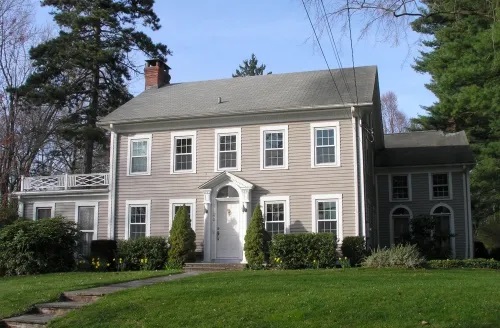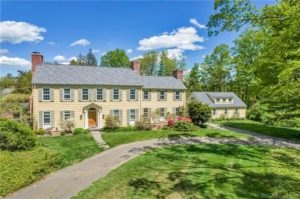By Emily Clark
In the years prior to the Great Depression, when residents of Connecticut were migrating from the cities to such suburbs as Hamden, Westville, and Woodbridge, homebuyers were drawn to Colonial Revival-style dwellings that embodied warmth and tradition. They found them then – and still treasure them today – in the work of an unlikely source: a female architect with no formal training but an eye for design.
A Time of Growth for Women
Born in Cheshire in 1870, Alice Washburn began her career as a high school teacher and principal before marrying in 1896. Some 20 years later, at age 49, she ventured into the business of designing homes. Though the background of her architectural skill is a mystery, her renown is not, as more than 80 of her 90-plus homes still remain in the greater New Haven area. These “Washburn Colonials,” as locals often call them, gained popularity in the 1920s during a period when less than one percent of architects were women. Since many others at the time were also untutored in the field, some say Washburn was in the right place at the right time to take advantage of this early housing expansion. The growth of female entrepreneurs in all professions blossomed then too, as Washburn began building in 1919 – the year Congress passed the 19th Amendment granting women the right to vote.
According to Christopher Wigren, the deputy director of the Connecticut Trust for Historic Preservation, Washburn’s work was part of the growing development of suburbia, as more residents of Connecticut had access to automobiles and penchants for quality in both modest cottages and grand mansions. Despite their size, all of Washburn’s structures showcase details from early American home styles and exude the charm and timelessness that allow them to be as popular today as a century ago. “She has a degree of quality that makes her stand out from her peers,” Wigren said.
This eye for quality and design made Washburn very particular about her work. Martha Finder Yellig, author of the 1990 book Alice F. Washburn, Architect, wrote that she was “well-known…for her close supervision of every facet of the construction process, including the interior decoration and landscaping. She even climbed ladders to inspect workmanship.” To keep the accuracy of her vision of a home, Washburn at times added details at her own expense if homeowners could not afford additional costs.
Popular Styles in Spring Glen and Westville
Though she built homes throughout the New Haven area, the greatest concentration can be found in Hamden, specifically in Spring Glen, with 46 dotting this residential neighborhood as farms were subdivided in the early 1920s. Located on such streets as Hawthorne Avenue, Hartford Turnpike, and Spring Glen Terrace, they are referred to as “an elegant Alice Washburn home” and “a classic Washburn colonial.” Built low to the ground so as not to reveal foundations, the structures boast gabled roofs, formal entryways, over-sized windows, and sweeping porches. Not all Washburn trademarks are identifiable from the curb, however. One home in Spring Glen has arched doorways and a surprise arched ceiling along with leaded glass, a transom window, and built-in cupboards.
In neighboring Westville, a section of New Haven bordering the town of Woodbridge, Washburn built another ten homes throughout the 1920s in what was originally called the “garden suburb” of the city. Like those in Spring Glen, these homes, including several on Alden and Central avenues, showcase hardwood floors, ornate glasswork, and bright sunrooms.
As Washburn’s reputation grew, local residents themselves commissioned her to design and build their dream homes. One of her most famous clients was Hamden writer Thornton Wilder. Built in 1929, his Colonial on Deepwood Drive has since been renovated, not unlike many of Washburn’s homes. As residents over the last decades looked to update and restore, portions of these houses, as with other older dwellings, have been altered or torn out.
Once the Great Depression hit, Washburn’s business struggled, and she was forced to declare bankruptcy in 1931 due to some financial risk-taking throughout her career. After her husband Edward died, she retired and lived with her sister in an apartment in her native Cheshire. It was there that she died in 1958 at age 88, with little public appreciation for her lasting impact on southern Connecticut’s housing landscape.
Though Washburn did not enjoy today’s recognition during her lifetime, her work has become so distinguished that the American Institute of Architects – Connecticut created the Alice Washburn Award, which “acknowledges excellence in traditional house design through the thoughtful adaptation of tradition to address 21st-century needs. Works are to be located in Connecticut and designed in a style broadly considered as ‘traditional.’” A renovated summer home in Cornwall, built by Washburn in 1928 and overlooking a lake, was the 2021 recipient.
This distinguished award is just part of the legacy Alice Washburn left behind. With so many of her graceful homes still standing, they are a testament to the detail and classic construction that have made Washburn Colonials true Connecticut treasures for the past 100 years.
Emily Clark is a freelance writer and an English and Journalism teacher at Amity Regional High School in Woodbridge.









